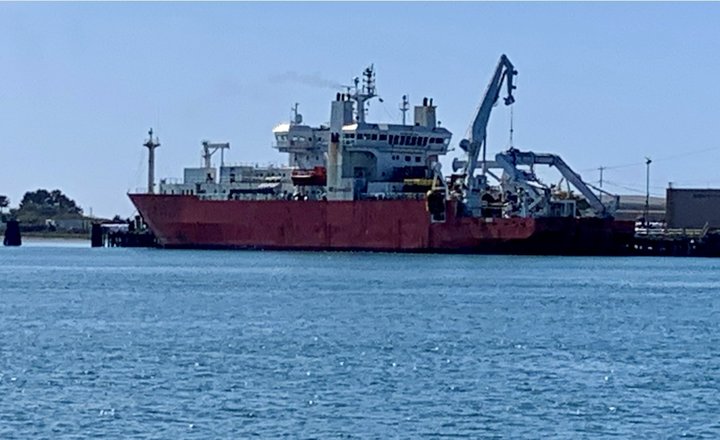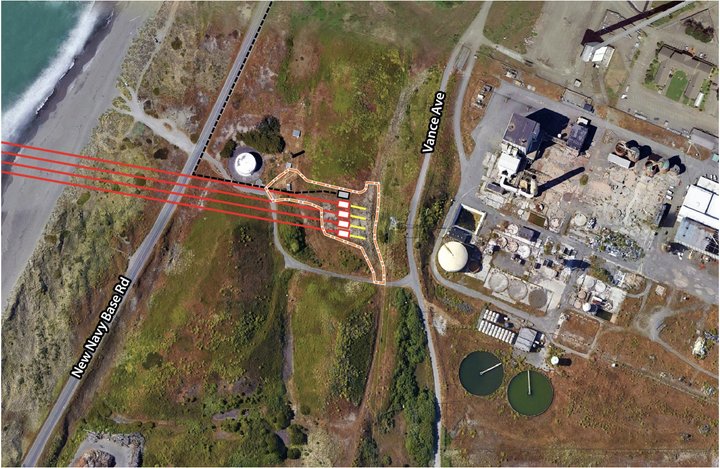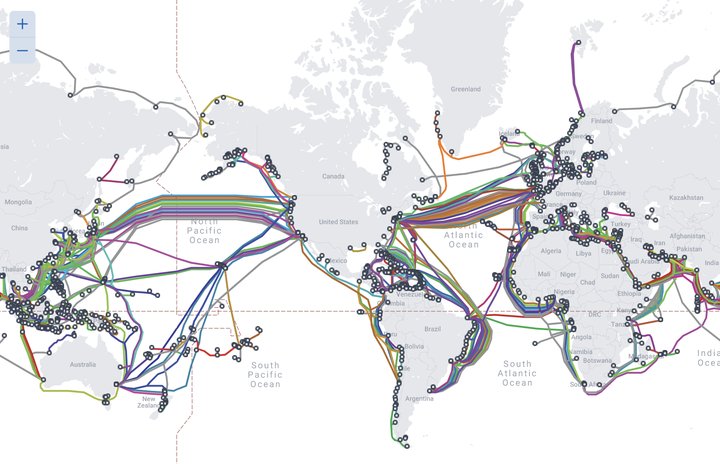
The Segero, a work vessel manufactured in 1998, docked at the Fairhaven Terminal on the Samoa Peninsula. | Photo via the Humboldt Bay Harbor, Recreation and Conservation District.
###
It’s happening. Construction has begun on infrastructure for two of the world’s longest fiber optic cables, which will stretch more than 10,000 miles along the bottom of the Pacific Ocean from the Samoa Peninsula to Singapore and Taiwan, respectively.
You may have noticed the bright orange hull of the Segero (pictured above) out in Humboldt Bay recently. The vessel has been working to pull fiber optic cables through conduits attached to a landing site near the old pulp mill property.
The project, dubbed the Echo Cable System, is being installed by RTI Infrastructure, and subsidiaries of both Google and Facebook have invested in the endeavor.
From the Samoa Peninsula, RTI Infrastructure used a diagonal drill to install 10-inch conduits, which have been sunk 50 feet below the ocean bed and extend 1.2 miles offshore. The Segero is being used to pull the fiber optic cables through that conduit, according to Larry Oetker, executive director of the Humboldt Bay Harbor, Recreation and Conservation District.

Diagram of the cable landing site and four landing pipes on the Samoa Peninsula. | Image via the California Coastal Commission.
The landing site is located on property owned by the Harbor District and slated to be developed as a land-based fish factory operated by Nordic Aquafarms.
In a recent phone conversation, Oetker explained a bit more about the fiber optic project. He said the Segero, that big orange-hulled ship, functions like a plow, burying the cables five feet beneath the sea floor until it’s about 30 miles offshore.
“That way it won’t have any impact on fisheries,” Oetker said. Beyond that 30-mile point, the cables will run along the bottom of the ocean.
Fishermen expressed concerns about the project during a June hearing of the California Coastal Commission. Humboldt Fishermen’s Marketing Association Vice President Ken Bates told commissioners that while his organization wasn’t opposed to the project, its members had “grave concerns” about the proposed mitigation efforts.
Before approving the project, the Coastal Commission added a few conditions of approval. One requires RTI Infrastructure to submit a Marine Wildlife Monitoring and Contingency Plan. The company also must notify fishermen of the location of the cable and adhere to a revised Fishing Agreement between fiber optic cable companies and the fishing industry.
The agreement is designed to avoid and mitigate conflicts between the installation, operation and maintenance of the cable projects and commercial fishing activities in the area.

Map of proposed routes of subsea cables via California Coastal Commission. The green and yellow routes are now being built.
You may also have noticed the recent and ongoing construction work along State Route 255 between Samoa and Arcata. While RTI Infrastructure works on the seaside part of the project, a Colorado-based company called Vero Fiber Networks is running the conduit from the landing site north into Arcata, where it will connect with a data center.
From there, Oetker said, the line will be installed along the existing broadband right-of-way that runs adjacent to State Route 299 east to the I-5 corridor near Redding. Once connected, the new fiber optic lines will become the latest connections in the world’s vast and growing network of submarine fiber cables.
The landing site connects to four steel pipes, leaving plenty of room for future connections. When Google announced the project, it boasted, “Infrastructure investments such as these can have a substantial, measurable impact on regional economic activity.”
Oetker said Harbor District personnel are excited about this development.
“It’s just another one of those things to get clean, green industries into Humboldt,” he said. “It will set the stage for future economics for our region. Most people won’t even notice it, but they will be receiving the benefits.”

Map of existing submarine fiber optic cables via TeleGeography. | Creative Commons License.
###
PREVIOUSLY:
- New, Superfast Internet From the Ocean? Harbor District to Hear $1.75 Million Proposal to Connect Humboldt to Undersea Cables
- That Superfast Undersea Internet? You’re Probably Not Getting It, Unless You are One of 307 People Who Live in Lewiston
- New Fiber Optic Line a Go! State Pledges $47 Million to Dredge Internet Up From the Sea, Thread Fat Pipe From Eureka to Redding
- A Bill Sitting on Governor Brown’s Desk Could Determine the Future of Broadband in Rural Humboldt and Beyond
- Major Datacenter Company Purchases Arcata Warehouse, Starts Filing Paperwork to Build Fiber Optic Line to Samoa Peninsula
- Major Datacenter Coming to Arcata Will Connect to High-Speed Fiber Optic Cables Running From Samoa to Singapore
- Google Is Putting Money Into That Fast Undersea Internet Cable Between Eureka and Singapore, and They Think It’ll be Done by 2023
CLICK TO MANAGE